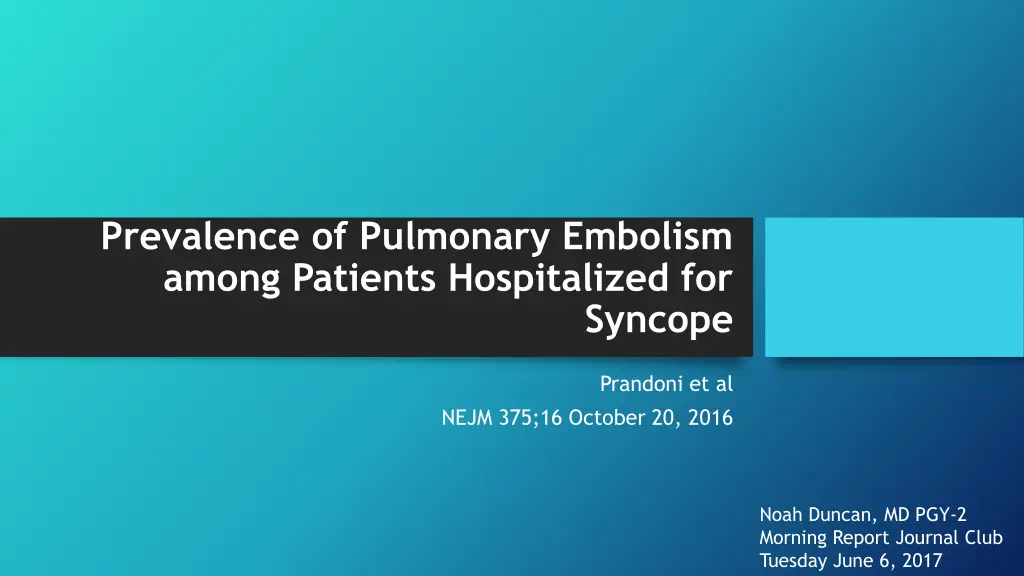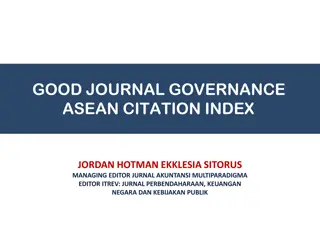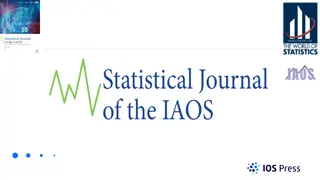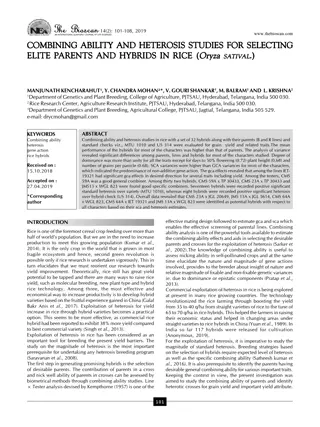
Prevalence of Pulmonary Embolism in Hospitalized Syncope Patients
This study investigates the prevalence of pulmonary embolism in patients hospitalized for their first episode of syncope. It highlights the importance of considering PE as a potential cause of syncope during diagnostic work-up. The research, conducted at 11 Italian hospitals, involved 560 patients aged 18 and above, presenting with syncope as their primary episode. Findings suggest a notable occurrence of PE in this patient population, emphasizing the significance of proper evaluation and management for syncope patients.
Download Presentation

Please find below an Image/Link to download the presentation.
The content on the website is provided AS IS for your information and personal use only. It may not be sold, licensed, or shared on other websites without obtaining consent from the author. If you encounter any issues during the download, it is possible that the publisher has removed the file from their server.
You are allowed to download the files provided on this website for personal or commercial use, subject to the condition that they are used lawfully. All files are the property of their respective owners.
The content on the website is provided AS IS for your information and personal use only. It may not be sold, licensed, or shared on other websites without obtaining consent from the author.
E N D
Presentation Transcript
Prevalence of Pulmonary Embolism among Patients Hospitalized for Syncope Prandoni et al NEJM 375;16 October 20, 2016 Noah Duncan, MD PGY-2 Morning Report Journal Club Tuesday June 6, 2017
Background Pulmonary Embolism is an established cause of syncope, but most current diagnostic guidelines for work-up of syncope pay little attention to PE. In patients admitted to the hospital for syncope PE is often not considered and may be missed.
Study Question What is the prevalence of PE in patients hospitalized for their first episode of syncope?
Study Design Cross-sectional study designed to determine prevalence of PE in patients older than 18 admitted for first episode of syncope Multicenter study done at 11 Italian hospitals (2 academic and 9 nonacademic) No randomization given it is a cross-sectional study
Funding Funded by research funding from the University of Padua (Italian university founded in 1222)
Inclusion Criteria 18 years old or older Hospitalized for first episode of syncope
Exclusion Criteria Previous episodes of syncope Less than 18 years old Not admitted On anticoagulation Pregnant
Patients 2584 patients presented to study centers ED for syncope. 1876 were discharged from the ED, and therefore excluded 717 were admitted. 157 of admitted patients were excluded 118 on anticoagulation 35 had prior syncope 4 declined to participate 560 patients included in the study.
Demographics Mean age 76 14 39.8% Male 6% Obese Does not give breakdown of comorbidities, even in the appendix
Are these patients similar to our patients? Hard to say without information on comorbidities Probably older Less obese
What did they do? In all the patients included in the study they checked a D-dimer and calculated a wells score, even when there was another potential etiology for syncope.
What else did they do? If D-dimer negative and wells score was less than or equal to 4 PE was considered to be ruled out If D-dimer positive and/or wells score was greater than 4 a CT scan or VQ scan was done to evaluate for PE There was one patient who died before CT or VQ scan could be done and an autopsy was done In patients with PE thrombotic burden was evaluated by a committee
What was the outcome of interest? Presence or absence of PE.
Results In 330 patients PE was ruled out based on negative D-dimer and wells score less than or equal to 4. 230 evaluated for PE (135 had pos D-dimer only, 3 had well s >4 only, 92 had both) 180 had CT scan 49 had VQ scan 1 had autopsy
Results Prevalence of PE 97 patients found to have PE, prevalence of 17.3% in the entire cohort PE found in 52 of 205 patients with no alternative etiology of syncope (25.4%, 95% CI 19.4 to 31.3) PE found in 45 of 355 patients with an alternative etiology of syncope (12.7%, 95% CI 9.2 to 16.1)
Results Extent of Thrombotic Disease In 49 of 73 patients with a PE on CT or autopsy (67.1%) the most proximal location of PE was main pulmonary artery, right/left pulmonary artery, or lobar artery. In 12 of 24 patients with a PE on VQ scan (50%) the perfusion defect was larger than 25% of total lung area 61 of 97 patients with PE (62.8%) had evidence of large PE
Results - Features associated with PE Tachypnea (R>20) Tachycardia (HR>100) Hypotension (SBP<110) clinical s/s of DVT h/o VTE Active Cancer 24 of 97 patients with PE (24.7%) had no clinical manifestations of PE
Follow Up There was no follow up.
Limitations No information or guidance on how PE was treated in patients where it was found. Other work-up of syncope was not standardized. Left to discretion of physicians. Didn t include patients on anticoagulation or with prior history of syncope. Didn t include patients not admitted to the hospital. No information on provoked VS unprovoked
More Limitations Limited by its design as a cross sectional study. Naturally raises questions it s not designed to answer. In what percentage, if any, was PE an incidental finding? What about the patients found to have small PEs? How should they be treated? Outcomes? Should we check well s score and D-dimer in every patient admitted with syncope?
Take Home Message PE is prevalent in patients admitted for syncope and should be part of your differential for a patient admitted for syncope. In a patient admitted for the first episode of syncope a Well s Score should be calculated and a D-dimer should at least be considered.






















